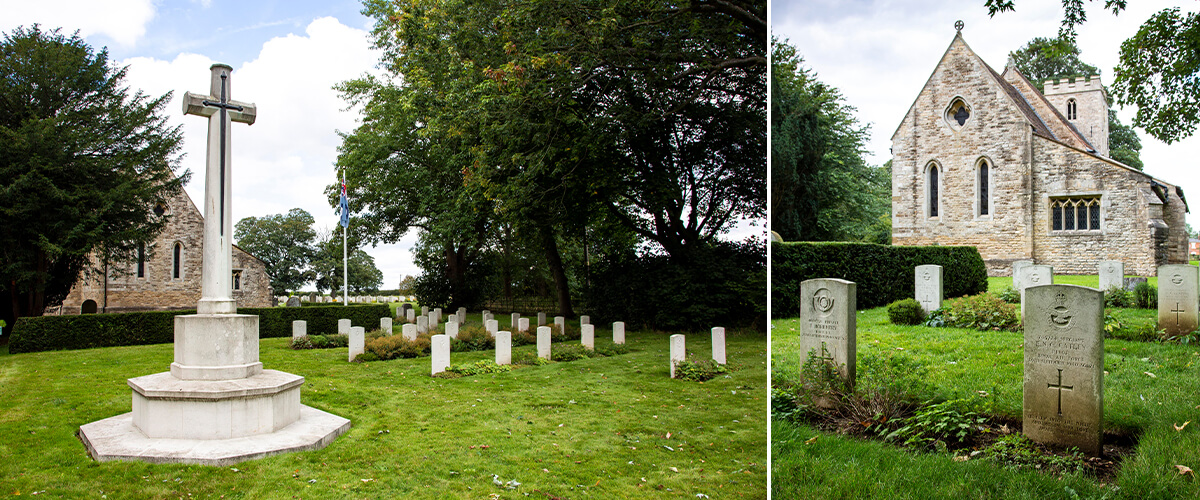The explosion left a lasting mark on the Staffordshire landscape. The Hanbury Crater, as the explosion site is now known, measures some 100 feet deep and 250 yards wide. It has now largely been reclaimed by nature. A tranquil and beautiful walk is possible around the perimeter, but the site itself remains the property of the Ministry of Defence and still contains explosives. Signs remain which forbid entry. In 1990 a small memorial to those killed was erected at the site and another exists at the National Memorial Arboretum.
26 June 2020
The Fauld explosion of the Second World War
The two World Wars left an indelible mark on the lands they were fought on. From the scarring left by the trenches on the countryside of the western front, to the remnants of the Mulberry harbour off Arromanches in France, these traces of war serve as a permanent reminder of the death and destruction suffered around the world. Here Sarah Moody, Public Engagement Coordinator (West Central), explores one explosive reminder of the Second World War that can be found in a quiet corner of Staffordshire.
 In the cemetery at Burton Upon Trent, Staffordshire, England, the Commonwealth War Graves Commission commemorates 151 servicemen who lost their lives in the two World Wars. These represent seven nationalities (not all from Commonwealth nations) and the Army, Navy and Air Force. So far, this is not particularly remarkable given the Commission’s purpose. On closer examination, you may notice that these include six Italian soldiers and one Royal Air Force corporal, all of whom died on 27 November 1944. This date is of note, but even locally, the events are not well known. At around 11.00 a.m. on this day, what is generally considered to be Britain’s largest ever explosion occurred. Sometimes referred to as the “forgotten disaster” it is believed to have caused the deaths of at least 70 people.
In the cemetery at Burton Upon Trent, Staffordshire, England, the Commonwealth War Graves Commission commemorates 151 servicemen who lost their lives in the two World Wars. These represent seven nationalities (not all from Commonwealth nations) and the Army, Navy and Air Force. So far, this is not particularly remarkable given the Commission’s purpose. On closer examination, you may notice that these include six Italian soldiers and one Royal Air Force corporal, all of whom died on 27 November 1944. This date is of note, but even locally, the events are not well known. At around 11.00 a.m. on this day, what is generally considered to be Britain’s largest ever explosion occurred. Sometimes referred to as the “forgotten disaster” it is believed to have caused the deaths of at least 70 people.
Historically, gypsum had been mined in the area and prior to the Second World War, the government purchased many acres of disused mining tunnels to use as underground storage for ammunition and bombs. They named the facility RAF Fauld. Up to 40,000 tonnes of high explosive and incendiary bombs, detonators and rifle ammunition could be stored there. It was also a repair centre for defective devices. Hundreds of people worked at RAF Fauld or close by in the plaster factory or on farms. At 11.00 a.m. on 27 November, around 4,000 tonnes of ordnance exploded, destroying around one third of RAF Fauld. Almost unbelievably, many who worked there escaped death: the thickness of the tunnel walls prevented the whole site from going up. But among the dead service personnel were six Italian prisoners of war whose graves are at Burton Upon Trent. Many bodies were never recovered and CWGC commemorates those men of the Royal Air Force who have no known grave on Runnymede Memorial in Surrey.


Fauld Crater from the air, 1944 © IWM CH 20852 (left), Fauld Crater from the air, 1970s. Courtesy of Tutbury Museum,‘Fauld Explosion file LH29’ (right)
 Civilian casualties were higher than military. On the old mine’s surface, Upper Castle Hayes Farm simply “disappeared” -- farmhouse, residents and livestock. The local pub, the Cock Inn, was demolished. The greatest devastation was caused by the bursting of a reservoir, releasing a huge flood into the nearby mine and plasterworks, drowning many. In the nearby village of Hanbury almost every house suffered damage from flood or debris and the population was left without vital services. The residents depended on the Women’s Voluntary Service to provide for their essential needs. People as far away as Birmingham and Coventry reporting hearing the blast, and seismologists as far as Switzerland noted it.
Civilian casualties were higher than military. On the old mine’s surface, Upper Castle Hayes Farm simply “disappeared” -- farmhouse, residents and livestock. The local pub, the Cock Inn, was demolished. The greatest devastation was caused by the bursting of a reservoir, releasing a huge flood into the nearby mine and plasterworks, drowning many. In the nearby village of Hanbury almost every house suffered damage from flood or debris and the population was left without vital services. The residents depended on the Women’s Voluntary Service to provide for their essential needs. People as far away as Birmingham and Coventry reporting hearing the blast, and seismologists as far as Switzerland noted it.
At the time, local people looked to blame enemy action for the explosion. Sabotage by prisoners of war who worked at the site was also suggested. The investigation, which was not publicly available until 1974, found that the cause was almost certainly simple human error. The use of incorrect equipment had caused a spark which detonated the bomb store, and the tragedy.
The civilian dead from the Fauld explosion are commemorated on the CWGC’s Civilian Roll of Honour in Westminster Abbey and online. They are part of a commemoration of more than 67,000 names ensuring that the civilian war dead of the Second World War are remembered. The Roll of Honour was suggested to Prime Minister Winston Churchill by CWGC’s Sir Fabian Ware and consists of multiple leather-bound volumes. They are found at the entrance to St George’s Chapel.


